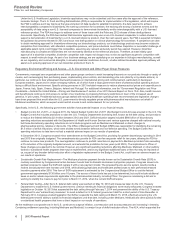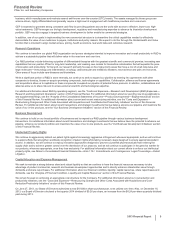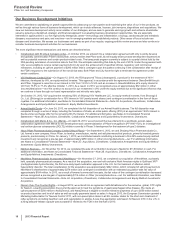Pfizer 2013 Annual Report Download - page 17
Download and view the complete annual report
Please find page 17 of the 2013 Pfizer annual report below. You can navigate through the pages in the report by either clicking on the pages listed below, or by using the keyword search tool below to find specific information within the annual report.
Financial Review
Pfizer Inc. and Subsidiary Companies
16
2013 Financial Report
Expected Annual Rate of Return on Plan Assets
The assumptions for the expected annual rate of return on all of our plan assets reflect our actual historical return experience and our long-
term assessment of forward-looking return expectations by asset classes, which is used to develop a weighted-average expected return based
on the implementation of our targeted asset allocation in our respective plans (see Notes to Consolidated Financial Statements—Note 11D.
Pension and Postretirement Benefit Plans and Defined Contribution Plans: Plan Assets for asset allocation ranges and actual asset allocations
for 2013 and 2012).
The expected annual rate of return on plan assets for our U.S. plans and the majority of our international plans is applied to the fair value of
plan assets at each year-end and the resulting amount is reflected in our net periodic benefit costs in the following year. Holding all other
assumptions constant, the effect of a 50 basis point decline in our assumption for the expected annual rate of return on plan assets would
increase our 2014 net periodic benefit costs by approximately $101 million, pre-tax.
The actual return on plan assets resulted in an increase in our aggregate plan assets of approximately $2.4 billion during 2013.
Discount Rate Used to Measure Plan Obligations
The discount rate used to measure the plan obligations for our U.S. defined benefit plans is determined at least annually and evaluated and
modified, as required, to reflect the prevailing market rate of a portfolio of high-quality corporate bond investments, rated AA/Aa or better, that
would provide the future cash inflows needed to settle our benefit obligations as they come due. The discount rate used to measure the plan
obligations for our international plans is determined at least annually by reference to investment grade corporate bonds, rated AA/Aa or better,
including, when there are sufficient data, a yield-curve approach. These discount rate determinations are made in consideration of local
requirements.
The measurement of the plan obligations at the end of the year will affect the amount of service cost, interest cost and amortization expense
reflected in our net periodic benefit costs in the following year. Holding all other assumptions constant, the effect of a 10 basis point decrease
in the discount rate assumptions would increase our 2014 net periodic benefit costs by approximately $30 million, pre-tax, and increase our
benefit obligations as of December 31, 2013 by approximately $421 million.
The change in the discount rates used in measuring our plan obligations as of December 31, 2013 resulted in a decrease in the measurement
of our aggregate plan obligations by approximately $2.2 billion.
Contingencies
For a discussion about income tax contingencies, see Notes to Consolidated Financial Statements—Note 5D. Tax Matters: Tax Contingencies.
For a discussion about legal and environmental contingencies, guarantees and indemnifications, see Notes to Consolidated Financial
Statements—Note 17. Commitments and Contingencies.
























